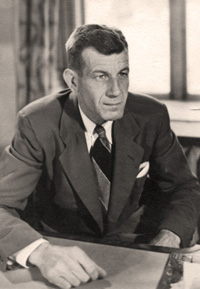Wesleyan's Eleventh President
 |
Victor L. Butterfield1943-1967 "The basic need [in education for democracy] is for insight and thinking power, for judgment and wisdom. A genuine democracy can survive whatever our material prosperity and power, only as its citizens are men of free minds and independent as well as cooperative spirit." |
Much to their amazement, freshmen arriving on campus during Victor Butterfield's tenure as Wesleyan president found that their president not only knew their names but also knew a fact about each of them. Butterfield's friendliness, eloquence, and hard work were legendary. Born on February 7, 1904, in Kingston, Rhode Island, Butterfield, whose father was, during his career, president of Rhode Island State, Michigan State, and Massachusetts State at Amherst, always wanted to be a teacher. He graduated from Cornell in 1927 and received a master's there in 1928. In 1936 he received a Ph.D. from Harvard.
After teaching at Deerfield Academy, the Riverdale School, and Lawrence College, he came to Wesleyan in 1935, where he served as director of admissions, philosophy instructor, dean of freshmen, associate dean, and acting president for one year.
When he was elected president in 1943, it was wartime. Many students had been drafted, but since Wesleyan was one of 131 colleges and universities chosen to host a nationwide officer training program on campus, Butterfield was pleased that the university could stay open. Faculty and administration adapted by compressing course work so that students could finish sooner, and some faculty learned other disciplines so that they could fill in because of the lack of personnel.
Butterfield realized that one of his major jobs was to build for post-war Wesleyan. He established personal contact with leading graduate schools in order to recruit a top-notch faculty. He wrestled with curricular decisions, knowing that many of the students who would be coming to campus after the war were more mature and had different perspectives. He looked for ways in which students could study independently.
Certain that liberal arts education would survive, Butterfield tried to find ways to make it more relevant both to students and to faculty. At the beginning of his tenure, he started the Freshman Humanities Program, an early interdisciplinary experiment. He developed the College Plan, envisioning Wesleyan as a collection of residential colleges, each with its own broad-based curriculum. Two of these survive today as the College of Letters and College of Social Studies.
Wesleyan's resources grew remarkably after World War II. In 1952, Wesleyan received the George and Harriet Davison Fund, more than $6 million, which was to be used for endowment. This bequest, combined with excellent portfolio management and the highly advantageous sale of American Education Publications to the Xerox Corporation, enabled the endowment to grow.
Butterfield, at once both philosophical and practical, oversaw not only curricular reforms, but an almost continuous building program. The Davison Art Center, Foss Hill Dorms, the Davison Rare Book Room, and an extensive campus renewal program enhanced the campus, while new graduate programs, including a Ph.D. programs in five disciplines, enhanced the curriculum, and the foundation was laid for the re-establishment of coeducation of Wesleyan.
As the longest-serving president in Wesleyan's history, Butterfield was a powerful force for change. He never lost his vision to "develop the freedom, the autonomy and the responsibility of the human mind and spirit" while guiding Wesleyan in matters more practical. He resigned on June 30, 1967, and spent the rest of his life on the many projects he enjoyed, until his death on November 19, 1975.
